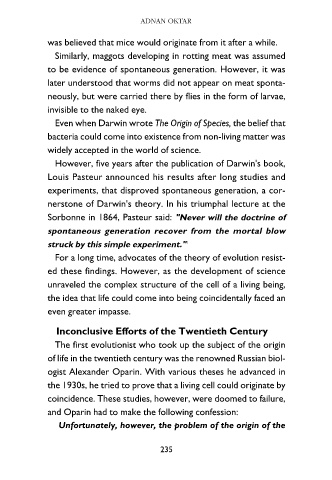Page 237 - The Importance of the Ahl Al-Sunnah
P. 237
ADNAN OKTAR
was believed that mice would originate from it after a while.
Similarly, maggots developing in rotting meat was assumed
to be evidence of spontaneous generation. However, it was
later understood that worms did not appear on meat sponta-
neously, but were carried there by flies in the form of larvae,
invisible to the naked eye.
Even when Darwin wrote The Origin of Species, the belief that
bacteria could come into existence from non-living matter was
widely accepted in the world of science.
However, five years after the publication of Darwin's book,
Louis Pasteur announced his results after long studies and
experiments, that disproved spontaneous generation, a cor-
nerstone of Darwin's theory. In his triumphal lecture at the
Sorbonne in 1864, Pasteur said: "Never will the doctrine of
spontaneous generation recover from the mortal blow
struck by this simple experiment." 1
For a long time, advocates of the theory of evolution resist-
ed these findings. However, as the development of science
unraveled the complex structure of the cell of a living being,
the idea that life could come into being coincidentally faced an
even greater impasse.
Inconclusive Efforts of the Twentieth Century
The first evolutionist who took up the subject of the origin
of life in the twentieth century was the renowned Russian biol-
ogist Alexander Oparin. With various theses he advanced in
the 1930s, he tried to prove that a living cell could originate by
coincidence. These studies, however, were doomed to failure,
and Oparin had to make the following confession:
Unfortunately, however, the problem of the origin of the
235

